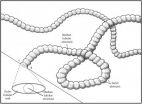(Press-News.org) TORONTO – A new drug approach has been developed for safer clean-up of deformed blood vessels in the eye by a research team at the Lunenfeld-Tanenbaum Research Institute, Mount Sinai Hospital in Toronto.
The growth of malformed blood vessels that can burst is a leading cause of vision loss in North America. Retinopathy and retina degeneration are associated with premature birth, with diabetes, and with increasing age.
Research just published by Dr. Andras Nagy and co-authors shows both safety and effectiveness in their bioengineered compound when treating retinopathy in mice. The therapeutic, which they called "Sticky-trap," shuts down tiny deformed blood vessels in the eye without affecting healthy vessels in other sites of the body.
The research appears in EMBO Molecular Medicine, which published a separate editorial stating that the compound "holds great promise as a strategy that could be rapidly translated into clinical practice. […] We expect that Sticky-trap and future related molecules will have significant impact on the field of tumour biology in local control of recurrent disease. […]"
Dr. Nagy is a Senior Investigator at the Lunenfeld-Tanenbaum and holds a Canada Research Chair in Stem Cells and Regeneration. He is a Professor in the Department of Obstetrics and Gynacology at University of Toronto and an Investigator at the McEwen Centre for Regenerative Medicine. Co-authors include colleagues from University of California Los Angeles, The Scripps Research Institute (La Jolla CA), University of Toronto, and the Lunenfeld-Tanenbaum.
Selective action is key to safety
Like some other treatments for retinopathy, Sticky-trap is injected into the eye. The potential game-changer is Sticky-trap's safety profile. It is stable and long-lasting once in the eye. If the compound gets into the circulation, it quickly inactivates – ensuring that it does not affect other blood vessels, tissues, and organs.
A problem in this research arena – called antiangiogenesis – has been finding a compound that is selective, closing off abnormal blood vessels only in the diseased organ while leaving all others intact. "That's difficult, and it's what makes this research high-risk as well as high-impact," Dr. Nagy says.
Type 2 diabetes illustrates the challenge. "Patients with diabetic retinopathy are losing vision because blood vessels in their eyes overgrow, become deformed and burst, often tearing the retina in the process. Drugs that suppress the excess vessel formation in the eye could negatively affect healthy organs if they escape into the blood, causing kidney function problems, poor wound healing, and hypertension," Dr. Nagy adds. These side effects are serious health threats that the Sticky-trap approach can avoid.
Advanced bioengineering
Over the nine years it took to bring the project to fruition, Dr. Nagy's team used cutting-edge genetic and pharmacological techniques to engineer the new two-step biologics. Sticky-trap includes a binding component that attaches to the surface of cells, ensuring that it remains in place and is stable, as well as the biologically active component. "That's important when a treatment involves injection directly into a diseased tissue," says first author Dr. Iacovos Michael, a post-doctoral fellow in the Nagy lab. "The longer-acting it is, the fewer injections a patient will need." He adds that the project "is just the beginning for the establishment of a new class of pharmacological entity, 'sticky' biologics, characterized by localized, targeted activity. The same principle could be used to develop similar local-acting biologics for other conditions such as inflammatory and autoimmune diseases."
Dr. Nagy is renowned for his work in stem cells, blood vessel biology, and creating genetic tools in cancer cells, among other areas. His team is also working on applications of the two step Sticky-trap for solid tumours.
Upon publication on May 6, Sticky-trap became available to biotech and pharmaceutical companies to adapt and develop.
"The significant advance in this approach is its built-in precision guidance system," says Dr. Jim Woodgett, Director of the Lunenfeld-Tanenbaum. "Worldwide research efforts have developed powerful agents that can treat diseased tissues but if they cannot be steered to where they are needed, they can also cause collateral damage. The initial application to diabetic retinopathy shows proof-of-principle in a very important disease, but the approach can be adapted to other powerful drugs and diseases where localized activity is needed."
INFORMATION:
The research paper is "Local acting Sticky-trap inhibits vascular endothelial growth factor dependent pathological angiogenesis in the eye," on-line May 6 2014 in EMBO Molecular Medicine. Funding was supported by the Canadian Institutes for Health Research, McEwen Centre for Regenerative Medicine, Robert and Sheryl McEwen, Canadian Cancer Society Research Institute, Mount Sinai Hospital Foundation, National Eye Institute, and Lowy Medical Research Institute.
For interview:
Polly Thompson
Lunenfeld-Tanenbaum Research Institute
Mount Sinai Hospital
Toronto, Canada
(416) 586-4800 #2046
pthompson@lunenfeld.ca
Plugging leaky blood vessels to save vision
Bioengineering a safe treatment for retinopathy, the leading cause of vision loss in Canada
2014-05-09
ELSE PRESS RELEASES FROM THIS DATE:
Paleontologists discover new fossil organism
2014-05-09
RIVERSIDE, Calif. — Scientists at the University of California, Riverside have discovered a fossil of a newly discovered organism from the "Ediacara Biota" — a group of organisms that occurred in the Ediacaran period of geologic time.
Named Plexus ricei and resembling a curving tube, the organism resided on the Ediacaran seafloor. Plexus ricei individuals ranged in size from 5 to 80 centimeters long and 5 to 20 millimeters wide. Along with the rest of the Ediacara Biota, it evolved around 575 million years ago and disappeared from the fossil record around 540 million ...
Discovery links rare, childhood neurodegenerative diseases to common problem in DNA repair
2014-05-09
(MEMPHIS, Tenn. – May 9, 2014) St. Jude Children's Research Hospital scientists studying two rare, inherited childhood neurodegenerative disorders have identified a new, possibly common source of DNA damage that may play a role in other neurodegenerative diseases, cancer and aging. The findings appear in the current issue of the scientific journal Nature Neuroscience.
Researchers showed for the first time that an enzyme required for normal DNA functioning causes DNA damage in the developing brain. DNA is the molecule found in nearly every cell that carries the instructions ...
Longevity gene may boost brain power
2014-05-09
Scientists showed that people who have a variant of a longevity gene, called KLOTHO, have improved brain skills such as thinking, learning and memory regardless of their age, sex, or whether they have a genetic risk factor for Alzheimer's disease. Increasing KLOTHO gene levels in mice made them smarter, possibly by increasing the strength of connections between nerve cells in the brain. The study was partly funded by the National Institutes of Health.
"This could be a major step toward helping millions around the world who are suffering from Alzheimer's disease and ...
Autism-related protein shown to play vital role in addiction
2014-05-09
BELMONT - In a paper published in the latest issue of the neuroscience journal Neuron, McLean Hospital investigators report that a gene essential for normal brain development, and previously linked to Autism Spectrum Disorders, also plays a critical role in addiction-related behaviors.
"In our lab, we investigate the brain mechanisms behind drug addiction – a common and devastating disease with limited treatment options," explained Christopher Cowan, PhD, director of the Integrated Neurobiology Laboratory at McLean and an associate professor of Psychiatry at Harvard Medical ...
Quick test can help spot depressed teenagers, UT Arlington nursing researcher finds
2014-05-09
A few minutes spent filling out a widely accepted mental health assessment in a health care provider's waiting room could make a big difference for some teenagers suffering from depression, according to new study from a nursing researcher at The University of Texas at Arlington.
Sharolyn Dihigo, a nurse practitioner and clinical assistant professor in the UT Arlington College of Nursing, recently examined available research to determine whether nurse practitioners and others in primary care settings should add a mental health screening to well visits for teenage patients. ...
Conducting polymer films decorated with biomolecules for cell research use
2014-05-09
The ability to create conducting polymer films in a variety of shapes, thicknesses and surface properties rapidly and inexpensively will make growing and testing cells easier and more flexible, according to a team of Penn State bioengineers.
"The ultimate goal of this collaborative project is to be able to create a substrate for growth and manipulation of cells," said Sheereen Majd, assistant professor of bioengineering. "Cells on a surface need to recognize biomolecules like extracellular matrix proteins to be able to adhere and grow. We ultimately would like to be able ...
Grape consumption may offer benefits for symptomatic knee osteoarthritis
2014-05-09
Fresno, CA – New research presented last week at the Experimental Biology conference in San Diego, California, suggests that regular grape consumption may help alleviate pain associated with symptomatic osteoarthritis of the knee, and improve joint flexibility and overall mobility. Researchers attribute these potential benefits to the polyphenols found in grapes.
The sixteen week clinical study, undertaken by Texas Woman's University, was designed to investigate the benefits of grape consumption on inflammation and osteoarthritis outcomes. 72 men and women with knee ...
Calcium supplements not associated with increased risk of cardiovascular disease in women
2014-05-09
Boston, MA – Calcium supplements are widely taken by women for bone health. Previous studies have suggested that calcium supplements may increase risk of cardiovascular disease, but the data has been inconsistent. A new study by researchers at Brigham and Women's Hospital (BWH) did not find that calcium supplement intake increases risk of cardiovascular disease in women.
The study is published online this month in Osteoporosis International.
Researchers examined supplemental calcium use and incident cardiovascular disease in a prospective cohort study of 74,245 women ...
Study validates air sampling techniques to fight bioterrorism
2014-05-09
ST. LOUIS – Air and surface sampling techniques currently used by the US government are effective in fighting bioterrorism and potentially saving lives, a Saint Louis University researcher finds.
Results published in Biosecurity and Bioterrorism by Alexander Garza, M.D., MPH, former chief medical officer at the Department of Homeland Security and a team of researchers from Los Alamos National Lab reviewed the data from a series of experiments simulating a bioterrorism attack against the Pentagon. Garza is now the associate dean for public health practice and associate ...
New species of metal-eating plant discovered in the Philippines
2014-05-09
Scientists from the University of the Philippines, Los Baños have discovered a new plant species with an unusual lifestyle — it eats nickel for a living — accumulating up to 18,000 ppm of the metal in its leaves without itself being poisoned, says Professor Edwino Fernando, lead author of the report. Such an amount is a hundred to a thousand times higher than in most other plants. The study was published in the open access journal PhytoKeys.
The new species is called Rinorea niccolifera, reflecting its ability to absorb nickel in very high amounts. Nickel hyperaccumulation ...
LAST 30 PRESS RELEASES:
Tracing the quick synthesis of an industrially important catalyst
New software sheds light on cancer’s hidden genetic networks
UT Health San Antonio awarded $3 million in CPRIT grants to bolster cancer research and prevention efforts in South Texas
Third symposium spotlights global challenge of new contaminants in China’s fight against pollution
From straw to soil harmony: International team reveals how biochar supercharges carbon-smart farming
Myeloma: How AI is redrawing the map of cancer care
Manhattan E. Charurat, Ph.D., MHS invested as the Homer and Martha Gudelsky Distinguished Professor in Medicine at the University of Maryland School of Medicine
Insilico Medicine’s Pharma.AI Q4 Winter Launch Recap: Revolutionizing drug discovery with cutting-edge AI innovations, accelerating the path to pharmaceutical superintelligence
Nanoplastics have diet-dependent impacts on digestive system health
Brain neuron death occurs throughout life and increases with age, a natural human protein drug may halt neuron death in Alzheimer’s disease
SPIE and CLP announce the recipients of the 2025 Advanced Photonics Young Innovator Award
Lessons from the Caldor Fire’s Christmas Valley ‘Miracle’
Ant societies rose by trading individual protection for collective power
Research reveals how ancient viral DNA shapes early embryonic development
A molecular gatekeeper that controls protein synthesis
New ‘cloaking device’ concept to shield sensitive tech from magnetic fields
Researchers show impact of mountain building and climate change on alpine biodiversity
Study models the transition from Neanderthals to modern humans in Europe
University of Phoenix College of Doctoral Studies releases white paper on AI-driven skilling to reduce burnout and restore worker autonomy
AIs fail at the game of visual “telephone”
The levers for a sustainable food system
Potential changes in US homelessness by ending federal support for housing first programs
Vulnerability of large language models to prompt injection when providing medical advice
Researchers develop new system for high-energy-density, long-life, multi-electron transfer bromine-based flow batteries
Ending federal support for housing first programs could increase U.S. homelessness by 5% in one year, new JAMA study finds
New research uncovers molecular ‘safety switch’ shielding cancers from immune attack
Bacteria resisting viral infection can still sink carbon to ocean floor
Younger biological age may increase depression risk in older women during COVID-19
Bharat Innovates 2026 National Basecamp Showcases India’s Most Promising Deep-Tech Ventures
Here’s what determines whether your income level rises or falls
[Press-News.org] Plugging leaky blood vessels to save visionBioengineering a safe treatment for retinopathy, the leading cause of vision loss in Canada




